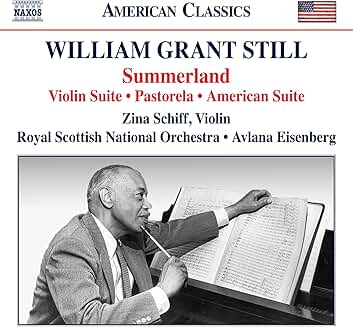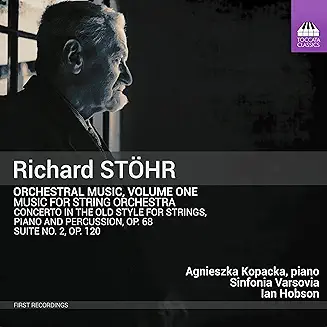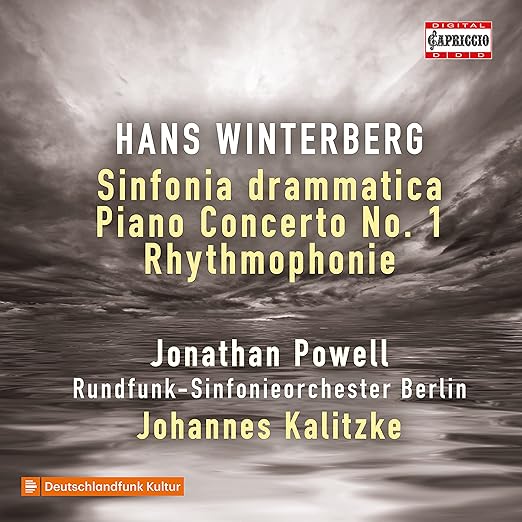Over the past few years Austrian-born and trained Richard Stöhr's (
1874-1967) chamber music has been well represented on Toccata (see
30 June 2020). Now they serve up their first volume of his orchestral fare with world premiere recordings of two delightful works.
The composer was an outstanding teacher whose students and associates included many of the big names in the world of classical music (see the album booklet). He also left a large body of
works across all genres, which over the past few years have been getting increased attention on disc.
This CD begins with his four-movement
Concert im Alten Stil (
Concerto in the Old Style). At almost 50 minutes, it's a monster, atavistic
concerto grosso, harkening back to
Baroque times. Here the
concertino could be considered as consisting of piano, timpani, side drum, cymbals and
glockenspiel, while the
ripieno is a string orchestra.
The opening "Intrata (Introduction):
Allegro giusto (Lively and Precise)" [T-1] is of
sonata-form persuasion, and begins with the strings playing a
dotted, angular idea (DA) [00:02] that the piano picks up in
fortissimo ben marcato (very loud and well accented) fashion [00:27]. Then DA is examined [01:26] and the pianist plays a related, singing thought (DS) [01:59], which is explored [02:23].
After that, DA initiates a dexterous development [03:38] and antsy restatement [08:15]. The latter has a
Poco animato (Somewhat animated) coda [09:27] that ends things with a flourish of three,
fortissimo strength,
staccato (detached) chords [09:49].
Then we get a "Quasi Sarabande und Scherzo (Like a
Sarabande and Scherzo): Andante religioso (Slow and religious)" [T-2]. It starts with what the composer described as "my sweet minuet" [00:03], which is based on a songful, weeping idea (SW) heard at the outset [00:12].
SW is explored and makes a fervent bridge [beginning at 04:17] into a
Più mosso scherzando (Little more lively and playful) scherzo episode [06:26] based on a flighty version of SW [06:33]. Then SW returns [08:00] and undergoes a reverent, developmental contemplation. This has some
morendo (dying) afterthoughts [11:55], which end the movement with a
fermata-marked, pianissimo chord.
Next there's a "Burleske und Aria (Burlesque and Aria)" [T-3]. This is best described as an extended scherzo, where its
Allegretto scherzando (Lively and playful), outer sections (OS) [00:00 & 08:22] are each based on an
alla turca-spiced tune heard at the outset.
They surround an
Andantino amabile (Leisurely and pleasant), romantic, trio-like one [04:09-08:21], which features a gorgeous idea that could well be the melody for some romantic aria. Then the concluding OS has a
staccato-accented coda [11:03] that ends things with a
fortissimo flourish [11:37].
The closing
rondo-like "Introduction und Finale (Introduction and Finale)" [T-4] begins with a
Grave (Serious) preface for all [00:00], which has a DA-related,
Più allegro (More lively) idea (DM) soon played by the piano [01:38]. DM will take on several guises throughout this movement, the first three being respectively flighty [02:33], romantic [03:12] and valiant [05:16].
Then after an anticipatory pause, there are sequentially martial [06:56], scurrying [08:07] and declaratory [08:31] ones. These are followed by a
Tempo des ersten Satzes (Tempo of the first movement) restatement of DA [10:35]. This brings the work full circle and ends it with a
tutti sforzando (played forcefully by all) flourish [11:08].
Filling out this disc, there's the composer's
Suite No. 2 in A minor for String Orchestra (Op. 120; 1947). Written during his happier years (see the album booklet), this five-movement work is a significant contribution to the genre.
The first
Andante maestoso (Slow and majestic) one [T-5] is a gentle, pastoral offering. It starts with a brief,
pizzicato bass line for the lower strings [00:00], soon followed by a gently, flowing melody intoned by the violins (GF) [00:09]. After that there's a
tutti forte (more forceful) restatement of GF [01:23], succeeded by a
piano dolce (softly sweet) interlude [02:15]. The latter bridges into a reappearance of GF [03:27], which is worked into some
piano (soft) closing moments [04:35].
The pace quickens with a subsequent
Molto vivace (Very vivacious) [T-6], which is as advertised. It features a cocky, galloping theme [00:02] followed by one somewhat reminiscent of the tune for that children's song, "
Row, Row, Row Your Boat" [00:52].
Subsequently there's an
Adagio con espressione (Slow with expression) [T-7]. Here a winsome thematic nexus (WN) [00:00] is the subject of a tender serenade, which comes to a tranquil,
pianissimo conclusion.
The next
Allegro leggiero e scherzando (Fast, light and playful) [T-8] is of whimsical disposition. However, there are some
poco tranquillo dolce (a little more tranquil and sweet) moments, one of which [02:14] ends this penultimate movement somewhat tentatively.
Then there's an "Introduction (Fuge) und Finale (Introduction (Fugue) and Finale)" [T-9]. It's a fugal concoction whose
Andante (Slow),
mezzo piano (moderately soft) opening moments present the main subject (MS) [00:01} that calls to mind WN [T-7, 00:00].
These bridge into a thrilling
Allegro con spirito (Fast and spirited) finale [01:31] having a couple of brief excursions to minor keys [03:23 & 04:04]. Then a perky,
l'istesso tempo (at the same speed) marked coda [04:42], brings this selection and disc to a
fortissimo conclusion.
Award winning, Polish pianist Agnieszka Kopacka delivers a superb rendition of the first selection, and receives outstanding support from the
Warsaw-based Sinfonia Varsova (SV) under English conductor Ian Hobson (
b. 1952). Then Maestro Hobson and his musicians give us a charming account of the other work, thereby making a strong case for these rarities.
The recordings were made 14-16 June 2021 at the Polish Radio's
Witold Lutoslawski Concert Studio located in
Warsaw. They present a generous sonic image in an appealing venue that enriches the overall sound. Ms. Kopacka's piano is placed centerstage, ideally captured and well balanced against the SV.
What's more, the instrumental timbre in both works is characterized by pleasant highs, a splendid midrange and clean bass. Consequently, this CD is about as good as conventional discs get, thereby earning it an "Audiophile" rating.
--
Bob McQuiston, Classical Lost and Found (CLOFO.com, Y221028)










